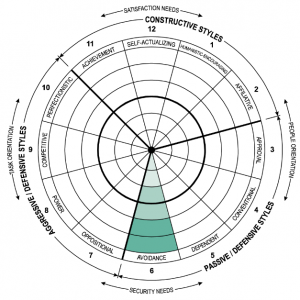In a previous article, we introduced the Human Synergistics Circumplex™, a proven framework to measure, report, discuss and better understand individual and collective human behaviours, and their impact upon business and organisation performance (refer: Catching Smoke: A Proven Framework for Addressing Culture and Leadership).
This latest article in this series focuses on one of the Passive/Defensive styles – Avoidance: what it is, how it can hinder your personal effectiveness and/or the performance of your business/ organisation and how to, at a personal and/or workplace culture level, reduce excessive Avoidance-oriented thinking and behaviour.

So Just What is the Avoidance Style?
Whether we’re looking at it from an individual leadership or broader workplace culture perspective, a driving characteristic of the Avoidance style is the want/need to stay safe by remaining in an established “comfort zone”.
Leaders high in the Avoidance style might tend to, for example:
- “lay low” when things get particularly tough
- not express strong views, opinions, or make firm commitments (they may appear indecisive)
- doubt their own ability to make a difference
- keep to themselves
- take low-risk options that are less prone to be criticised, even if it also means low reward, and
- avoid difficult conversations and any form of potential or actual conflict.
Workplace cultures can themselves take on some characteristics of the Avoidance style, in which it becomes acceptable or even desirable for participants to, for example:
- shift responsibilities onto others
- hide their own mistakes, shortfalls and problems
- ensure conflict remains below the surface
- not make clear decisions or express clear opinions, and
- present only safe ideas.
So Why Should I/We Focus on Limiting the Avoidance Style?
Research over several decades by Human-Synergistics has consistently shown that workplaces high in the Avoidance style (and other Defensive styles) are significantly less effective than workplaces with predominantly Constructive cultures.
Indeed, primarily constructive workplaces:
- are 32% more able to effectively respond to changes in the external environment
- achieve 32% higher quality performance
- demonstrate 28% more effective teamwork
- have a 25% greater commitment to producing a quality result
- have individuals that are 32% more motivated, 26% more satisfied and 25% more likely to stay with the organisation.
Individual leaders engaged in Avoidance thinking and behaviour may find it tough to, for example, make decisions (particularly more challenging ones that carry an element of risk and/or potential discomfort or conflict in terms of their relationships with others), hold others to account for their performance, relate easily to others or state their clear position on an issue.
Similarly, workplace cultures high in behaviours characterised by the Avoidance style might tend to:
- be slow to confront challenges and/or take advantage of opportunities
- be more focused on finding and punishing mistakes than recognising and rewarding good performance
- focus on protecting/maintaining the status-quo rather than vigorously pursuing growth and improvement opportunities, and
- lean toward seeking full consensus and compromise rather than taking what might be objectively the “right” decision.
It’s important to note that a modest level of Avoidance-orientated thinking and behaviour can on occasion be helpful. Sometimes, for example, it’s just not the right place of time to have a difficult conversation, to take a more significant risk or express a strong opinion. It’s when Avoidance thinking and behaviour is present to the extent that we never have the difficult conversations, we always default to the “safe” option and/or we only rarely make known our views, that it can hinder our personal effectiveness. From an organisation/business perspective, if Avoidance prevails to such an extent that it becomes part of “how we do things around here”, it’s our collective effectiveness and performance that will ultimately suffer.
OK, So How Can We Reduce Avoidance?
If you’ve come to the conclusion that your own performance, and/or that of your business/organisation might be hindered by an overdose of Avoidance thinking and/or behaviour, there are some things you can you do to reduce its presence and get back on track.
At an individual leadership level, for example:
- be mindful of negative “self-talk” and work on being more in touch with your own feelings
- move out of your personal comfort zone occasionally, selectively at first (express your view even if it might be contrary to others, or take a modest risk for example)
- work on more effectively engaging with others
- learn to recognise when something is making you uncomfortable or prone to avoidance behaviour, and make a commitment to deal with it sooner than later, and/or
- focus on achievement (plan to get stuff done, do it, then reflect on and recognise your work/impact).
At a collective/workplace level, for example:
- encourage others to express their views (in a constructive, helpful way of course), and be sure that it’s a safe environment for them to do so
- hold people accountable; don’t allow them to shift responsibilities/decisions that are rightfully theirs, to others. If they do, call them on it.
- ensure as a team/organisation that mistakes and shortfalls are handled constructively, so that future mistakes and shortfalls are acknowledged and regarded as learning experiences rather than hidden away or the blame shifted to others
- have the courage to make the “right” rather popular decisions, and/or
- make a real effort to recognise and reward good performance/outcomes, particularly where those good outcomes arise from “thinking outside of the square” or taking a well-considered risk.
If you’ve missed our articles on the other styles, search our blog for the “Focus on Culture and Leadership” series of articles. And of course, call us if you’d like to explore the range of culture and leadership programs we have available to help transform your people, your team and your business/organisation.
